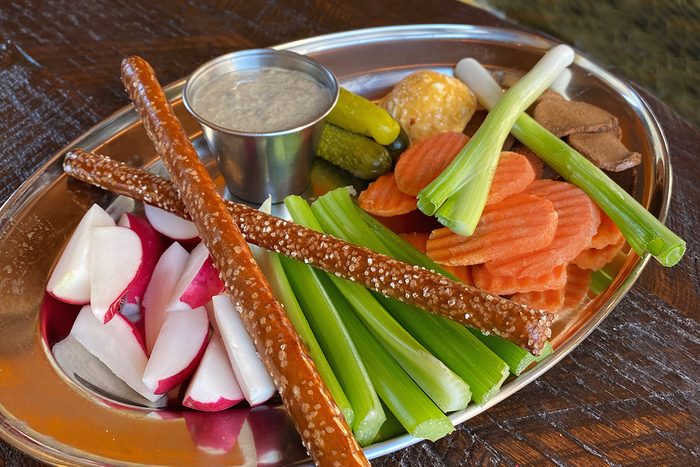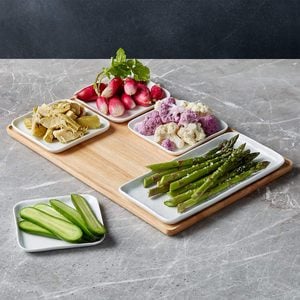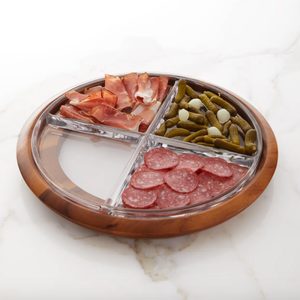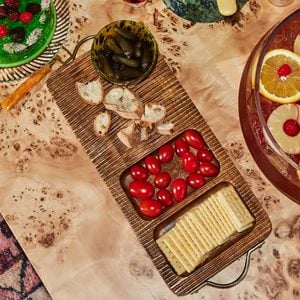What Is a Relish Tray and What Should You Put on It?
Updated: Feb. 06, 2024

A relish tray is a nostalgic appetizer platter that's just the thing for kicking off rich meals.
Enter an old-fashioned supper club or attend a holiday dinner at any Midwesterner’s home and you’ll find one constant on every table: the relish tray.
If you’re not from the Midwest or a family that can’t resist putting out a tray of pickles and olives at any family function, you might just be missing out on a refreshing prelude to a big meal.
What is a Relish Tray?
A relish tray is a platter of fresh veggies, spreads and extras that’s served up before dinner at steakhouses and supper clubs or alongside dinner when served at dinner parties. According to Tyler Nation, general manager at Buckatabon Tavern & Supper Club in Wauwatosa, Wisconsin, these trays are “a warm-up to dinner.”
These preludes are filled with fresh vegetables, pickles and a few rich spreads. Tyler says that when it comes to relish tray components, “they have to be crave-able, dippable, spreadable and sharable.”
What goes on a Relish Tray?
“There’s a lot of nostalgia with relish trays,” says Tyler. Generations of folks have been enjoying these platters and there are some components that diners expect.
This being said, there are no absolute fixed pieces to a relish tray, just a few basics that you’ll find over and over again.
- Fresh vegetables: Fresh is key on a relish tray. Carrots, celery, radishes, broccoli florets and green onions are all welcome. These veggies make up most of the spread.
- Pickles and olives: While veggies may comprise most of the plate, pickles and olives are a critical component. Baby dills are my personal favorite, but homemade pickles of any kind—including pickled beets and mushrooms—are welcome.
- Dips or spreads: At Buckatabon, you’ll find scratch-made beer cheese spread and chicken liver spread on every relish tray. While the liver pate may seem out of the ordinary, this nostalgic dip is welcome here.
- Crackers: Besides fresh veggies, you’ll want other crunchy items for dipping, like crackers, pretzels and rye chips.
How Relish Trays are Different from Charcuterie Boards
While these trays share similar elements to a charcuterie board, Tyler says that they are not the same. Cheeses and meats are the stars of any charcuterie board; pickles, nuts and accouterments are just supporting players.
With relish trays, “freshness is what people really love,” according to Tyler. These spreads are comprised mostly of fresh elements with just a few decadent dips and extras. “They’re not as filling,” Tyler says.
This last part is key since diners are typically at a supper club to enjoy decadent dinners like prime rib, steak or a fish fry.
How to Elevate Your Relish Tray
While many Midwestern relish trays are full of basics like veggies and store-bought pickles, there are some ways that you can take this appetizing spread to the next level.
- Go homemade: There’s no shame in the store-bought game (there are some amazing prepared dips and snacks out there), but you can up the ante by making your own cheese spread, crackers and pickled veggies. Senior Food Stylist Shannon Norris recommends this pimiento cheese spread and pickled mushrooms.
- Blanch your veggies: An easy trick to elevate your spread is to blanch your green veggies, according to Deputy Food Editor James Schend. “It gives them a bright, fresh color while still keeping the crisp snap of raw veggies.”
- Try the unexpected: While relish trays are a Midwestern tradition, Tyler explains that relish trays are “evolving and changing,” especially at home. “I’d go more adventurous at home,” Tyler says. This can mean adding some extra spice like a spicy cranberry cheese spread or unexpected additions like pickled chard.
Choosing Your Own Serving Tray
Because relish trays are such a nostalgic addition to your soiree, we recommend raiding your own cupboards (or Mom’s or Grandma’s) for a vintage serving tray. My parents’ cabinets are full of small, divided glass dishes perfect for separating the olives from the pickles from the green onions.
If your family doesn’t have a retro dish to lend you, check out antique stores and thrift shops. They’re often full of these bits of serveware in all sorts of styles from depression glass to cut crystal to stoneware in retro hues.
However, if you’re gifting one of these relish trays (or just want to treat yourself), you’ll likely want to buy new. There are plenty of lovely options out there. Here are some of my favorites that I’ve been bookmarking—just in case my ’70s server ever shatters.
While any pretty serving tray will do to serve up your favorite pickles and cheese dip, I prefer divided dishes. That way you can keep the pickled herring from getting the crackers soggy. Need a pickled herring recommendation? My family would say Ma Baensch hands down.



